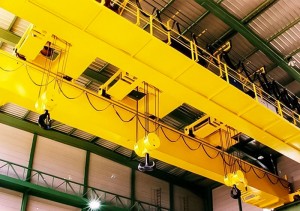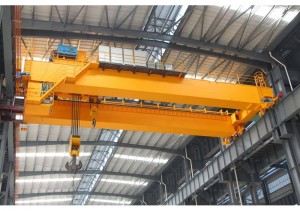
Heavy Duty Double Girder Overhead Crane with Hoist Lifting
Heavy-Duty Applications of Double Girder Overhead Cranes
Double girder overhead cranes are designed for demanding industrial environments where strength, reliability, and precision are essential. With their ability to handle extremely heavy loads and provide stable lifting performance, these cranes play a vital role across a wide range of heavy-duty applications.
Steel & Metal Processing: In steel mills, fabrication workshops, and metal processing plants, double girder cranes are indispensable. They are used for lifting raw steel, large metal coils, heavy sheets, and finished products. Their high load capacity and durability allow them to operate continuously under extreme conditions, ensuring safe and efficient handling of bulky materials.
Construction & Infrastructure: On construction sites, especially in bridge building and large-scale infrastructure projects, double girder cranes provide the power and precision required to move and position heavy structural components. Their extended span and lifting height capabilities make them suitable for handling large beams, precast elements, and other oversized materials with accuracy.
Shipbuilding & Aerospace: The shipbuilding and aerospace industries demand precision handling of massive and complex components. Double girder overhead cranes, often customized with advanced control systems, enable smooth and accurate positioning of ship blocks, aircraft parts, and other critical structures. Their stability and reliability ensure quality and safety during assembly.
Power Generation: Power plants—whether nuclear, fossil fuel, or renewable—rely heavily on double girder cranes for both installation and ongoing maintenance. These cranes are used to lift turbines, generators, and other large components that require precise handling and secure movement within restricted spaces.
Heavy Manufacturing: Manufacturers of large-scale machinery, heavy equipment, and industrial products depend on double girder overhead cranes throughout their production and assembly processes. Their ability to support repetitive, heavy-duty lifting operations makes them an essential tool in maintaining productivity and efficiency.
In summary, double girder overhead cranes provide unparalleled lifting solutions for industries where strength, safety, and precision are non-negotiable. Their wide-ranging applications highlight their critical role in modern heavy-duty operations.
Factors Affecting Double Girder Overhead Crane Prices
When investing in a double girder overhead crane, understanding the factors that influence its price is essential for making an informed decision. Several key elements determine the overall cost, ranging from technical specifications to operational requirements.
Load Capacity: The load capacity is one of the most important factors influencing price. Double girder overhead cranes are typically chosen for heavy-duty lifting tasks, with capacities ranging from 20 tons to more than 500 tons. As the lifting capacity increases, the crane requires stronger girders, larger hoists, and more powerful motors, which naturally raise the overall cost.
Span Length: The span length, or the distance between runway rails, also plays a significant role in pricing. Longer spans require extended girders and additional reinforcements to ensure stability and safety. This increases both material and production costs. Choosing the right span length according to your facility’s layout helps balance cost efficiency and operational coverage.
Lifting Height (Height Under Hook): The lifting height refers to the maximum vertical distance the crane hook can reach. A higher lifting height requires a larger structural design and more advanced hoist systems, adding to the cost. However, for industries handling bulky equipment or tall structures, this investment ensures smooth and efficient operations.
Hoist and Travel Speed: Faster lifting and trolley speeds improve productivity but also require high-performance motors and advanced drive systems. While this increases the price, it can significantly reduce downtime and enhance efficiency in high-demand operations.
Control System: Modern double girder cranes offer multiple control options, including pendant control, radio remote control, and operator cabins. Advanced control systems with features like anti-sway technology, automation, and precise load monitoring add to the cost but greatly improve safety and ease of use.
Customization and Special Features: If your operation requires custom attachments such as grabs, magnets, or spreader beams, or if the crane needs to withstand extreme environments like high temperatures or corrosive conditions, the cost will be higher due to specialized engineering and materials.
In summary, the price of a double girder overhead crane depends on capacity, span, lifting height, speed, control system, and customization. Evaluating these factors in relation to your operational needs ensures that you select the most cost-effective solution without compromising safety or performance.




FAQ
1. What industries typically use double girder overhead cranes?
Double girder overhead cranes are widely used in steel production, heavy manufacturing, construction, shipbuilding, aerospace, and power generation. They are ideal for applications requiring high lifting capacities and extended spans.
2. What is the typical lifting capacity of a double girder crane?
Depending on the design, double girder overhead cranes can handle loads ranging from 20 tons to over 500 tons. This makes them suitable for heavy-duty lifting tasks that single girder cranes cannot accommodate.
3. How long does a double girder crane usually last?
With proper operation, maintenance, and periodic inspections, a high-quality double girder overhead crane can last 20–30 years or even longer, making it a long-term investment for heavy industries.
4. Can double girder cranes be customized?
Yes. They can be tailored with special attachments such as grabs, magnets, or spreader beams, as well as advanced features like automation, anti-sway systems, and explosion-proof components for hazardous environments.
5. What is the installation process like for a double girder crane?
Installation typically involves setting up the runway beams, assembling the main girders, mounting the hoist and trolley, connecting the electrical system, and conducting a series of safety tests before operation. Professional installation and commissioning ensure maximum performance and safety.
6. What control options are available?
Double girder cranes can be operated by pendant control, radio remote control, or cabin control. Remote and cabin controls are especially useful in large-scale operations where visibility and operator safety are priorities.
7. Are double girder cranes expensive to maintain?
While they require regular maintenance, modern designs with advanced components minimize downtime. Routine inspections of hoists, wire ropes, brakes, and electrical systems help extend service life and reduce unexpected costs.
8. Why should I choose a double girder crane over a single girder crane?
If your operations demand frequent heavy lifting, extended spans, or higher lifting heights, a double girder crane is the better choice. It provides greater strength, stability, and versatility, ensuring long-term value and operational efficiency.
















